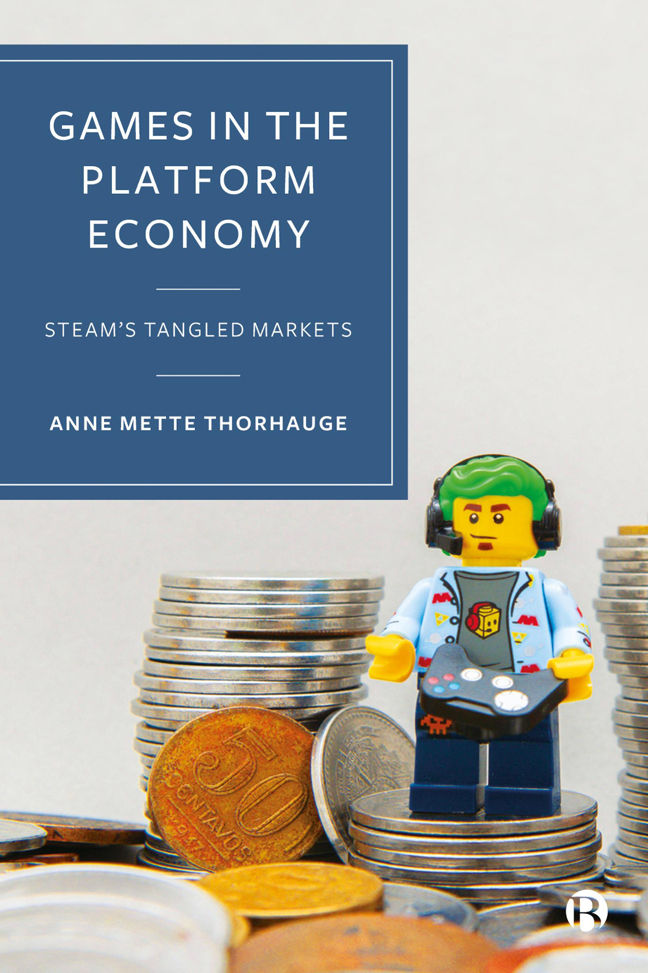Book contents
- Frontmatter
- Dedication
- Contents
- List of Figures and Table
- Acknowledgements
- 1 Introduction: Steam's Tangled Markets
- 2 Platform Configurations in Gaming
- 3 Economic Sociology and the Analysis of Platforms as Markets
- 4 Valve Corporation and the Steam Platform
- 5 Steam's Business Model
- 6 Shaping Market Interactions on the Steam Platform
- 7 Economic Actors on the Steam Platform
- 8 Player Trading beyond Steam
- 9 User Monetization and Value Creation in Tangled Markets
- Notes
- References
- Index
1 - Introduction: Steam's Tangled Markets
Published online by Cambridge University Press: 23 January 2024
- Frontmatter
- Dedication
- Contents
- List of Figures and Table
- Acknowledgements
- 1 Introduction: Steam's Tangled Markets
- 2 Platform Configurations in Gaming
- 3 Economic Sociology and the Analysis of Platforms as Markets
- 4 Valve Corporation and the Steam Platform
- 5 Steam's Business Model
- 6 Shaping Market Interactions on the Steam Platform
- 7 Economic Actors on the Steam Platform
- 8 Player Trading beyond Steam
- 9 User Monetization and Value Creation in Tangled Markets
- Notes
- References
- Index
Summary
In 2018, Valve Corporation, the owner of the Steam gaming platform, made a seemingly minor feature change. It involved that game items obtained in Steam-based games could only be traded between players after a waiting period of seven days after acquisition. This feature change, often referred to as ‘the cooldown’, cost the most active Steam traders several thousands of euros due to the subsequent plunge in market prices. It was implemented as a response to rising public concern regarding the proliferation of so-called skin trading and skin gambling on shady websites. In the time leading up to the event, several critical voices had accused Valve of profiting from illegal gambling with items from the Steam platform. ESPN.com stated that Counter-Strike: Global Offensive, one of Steam's most lucrative game titles, had ‘spawned a wild multibillion-dollar world of online casino gambling; it's barely regulated and open to any kid who wants in’, and the Washington State Gambling Commission stated that Valve was ‘responsible for the unregulated Counter-Strike: Global Offensive gambling that's gone on through Steam’ and ordered Valve to take immediate action. In the wake of these critiques, Valve was facing several lawsuits.
But how can a simple time delay cost ordinary users thousands of euros, and how can a simple feature change make a difference on seemingly unaffiliated websites? How is it even possible to gamble with items from Steam-based games? To understand these issues, one must understand the distinct features of the Steam platform economy and design, and how these frame economic practices beyond the platform. In this book, I will explain Steam as a ‘tangled market’, a set of interconnected and mutually dependent market contexts, that creates revenue from microtransactions through the strategic shaping of market interactions on and beyond the platform. Unlike other market platforms such as the App Store and Google Play, Steam does not offer entrepreneurs a system for generating revenue through advertising. Instead, it pushes its microtransaction system as a preferred alternative. And unlike other gaming platforms, Steam, to an unprecedented degree, integrates virtual economies and players’ economic interaction in an effort to intensify and expand the quantity of economic transactions on the platform and let these practices develop beyond the platform.
- Type
- Chapter
- Information
- Games in the Platform EconomySteam's Tangled Markets, pp. 1 - 19Publisher: Bristol University PressPrint publication year: 2023



